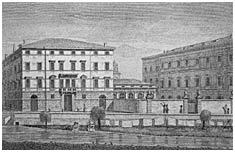| TREVISO FROM ITS ORIGINS TO THE END OF 15th CENTURY |
| |
| According to the history of Treviso, the first
settling sprang up where there is the Chiesa di Sant’Andrea today before the arrival of the Romans; it’s exactly
with the Roman Empire Treviso became an important trade centre getting the Roman citizenship and the
name " tarvisium ". |
 |
| |
| When the Roman Empire fell, the barbarian invasions (Visigoths, Huns, Ostrogoths, Goths
and Lombards) followed; then, about the year 1000, a process of growth began and it led Treviso to become a
city-republic town. |
| |
|
|
Around 1000:
 |
Treviso was protected by walls which surrounded a less wide area of town
than that existing one, built in 16th century. |
| |
| 1306: |
Gherardo da Camino died after governing the town for 22 years and his body was
buried in the Chiesa di San Francesco (Church of St. Francis). |

Casa Bortolan - 1846 Engraving by Antonio Nani. (Biblioteca Comunale di Treviso) |
| |
| 1314: |
Nine university students became doctors at law. |
| |
| February 11, 1344: |
The town Council decide to form an alliance freely with Venetian
Republic, this agreement lasted some centuries. |
| |
|
| February 4, 1384: |
Francesco da Carrara seized Treviso. |
| |
|
|
| 1388: |
Francesco da Carrara had to surrender the town to Venice, this fact was as
appreciated that its anniversary was celebrated by a mass. |
| |
|
| 1402: |
The Venice control extended over Treviso as well as over Bassano, Feltre,
Montagnana, Legnano, Belluno, Este and Monselice. |
| |
|
| 1406: |
Padua was taken also by the Maritime Republic; the same fate concerned
Vicenza after few decades. |
| |
|
| 1450: |
The river Piave in flood could damage Treviso with its waters. |
| |
|
| 1481: |
Federico III, Germany emperor, visited Treviso. |
| |
|
| End of 1400: |
The kings of France, the Holy See, the Dukedom of Ferrara, of Mantua, of Spain
and so on united into League of Cambrai; they were attracted by enormous wealth of Venice.
The Maritime
Republic realized danger and power of the front it had to oppose and thus it left leave Treviso free to
decide on its fate: united to Venice or free from this one. |
| |
|
| 14 Luglio 1496: |
Nicolò Franco, the bishop, founded the Monte di Pietà (Pawnshop). |
| |
|
| |
GO ON >>> |


